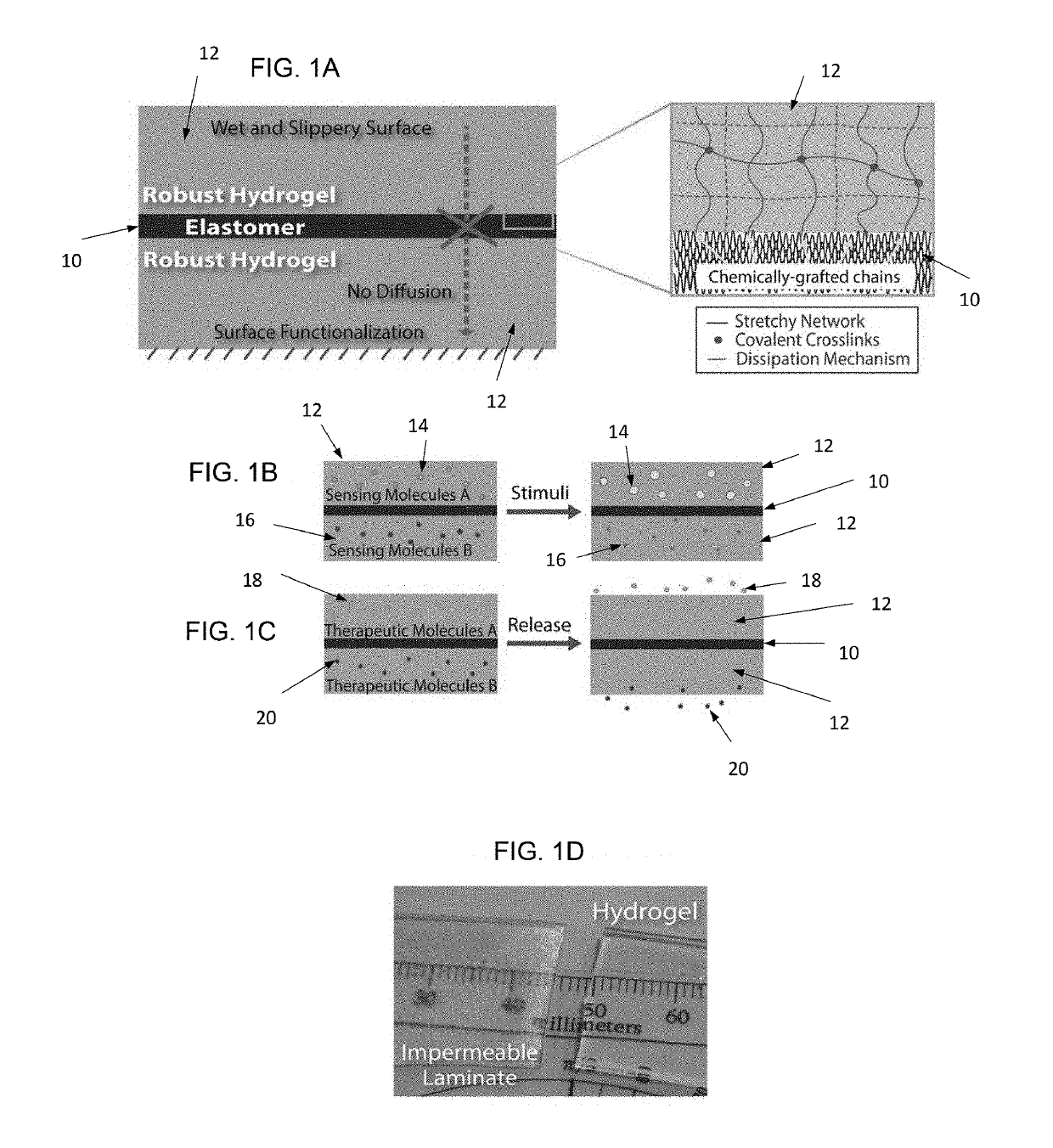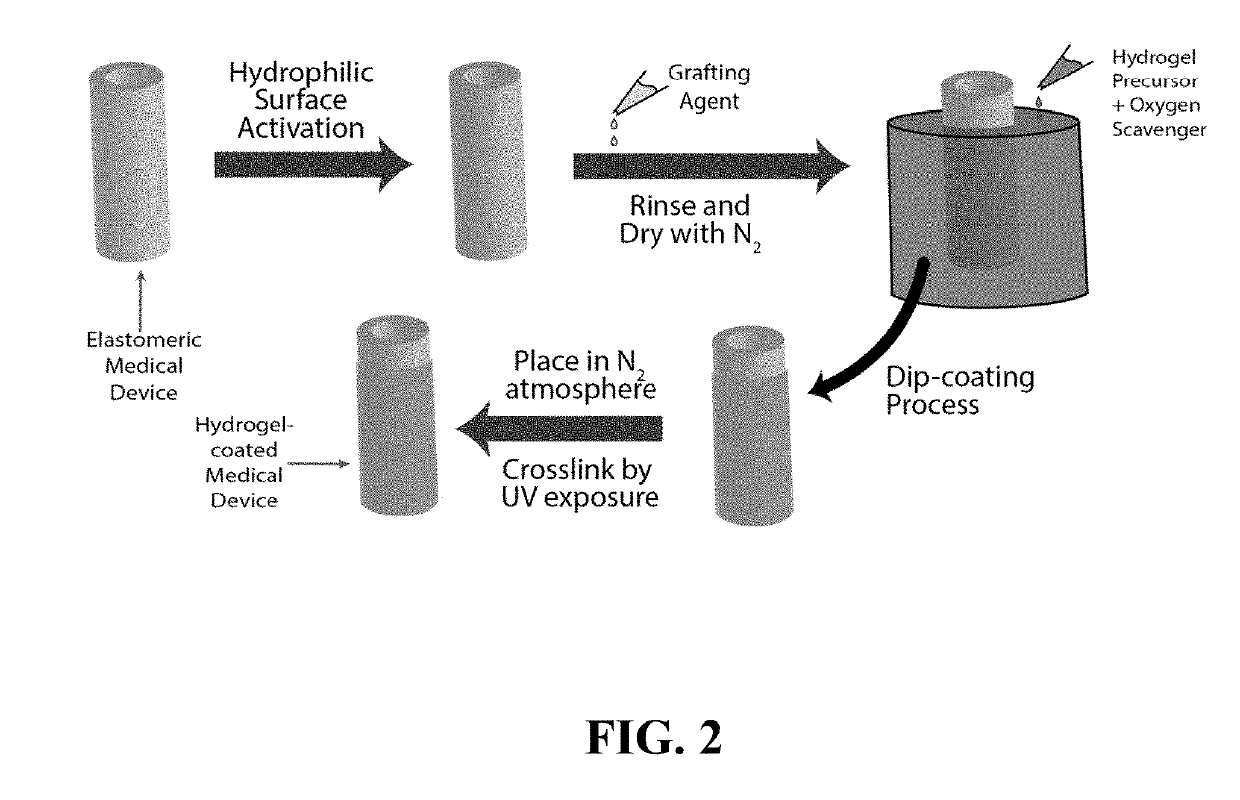Tough hydrogel coating and method of manufacture
a technology of which is applied in the field of tough hydrogel coating and manufacturing method, can solve the problems of low mechanical robustness, low tensile strength, and significant hampered potential use potential of these applications, and achieves the effects of high hydration, ultra-low friction, and tough enough to handle manipulation
- Summary
- Abstract
- Description
- Claims
- Application Information
AI Technical Summary
Benefits of technology
Problems solved by technology
Method used
Image
Examples
example 1
MECHANICAL PROPERTIES
[0065]To characterize the in-plane mechanical properties of the present invention hydrogel-elastomer laminates and individual components, uniaxial tensile tests were carried out with a mechanical testing machine at a strain rate of 1.0 min −1. The chosen materials for the laminates were latex elastomer (McMaster Carr) and PAAm-ALG tough hydrogel as discussed above. The samples were analyzed as prepared or after soaking in 1X phosphate buffer saline (PBS; Sigma-Aldrich) for 24 hours.
[0066]The solid dark blue and green curves in FIG. 5A show the nominal stress versus stretch curves of as-prepared single-material latex and PAAm-ALG hydrogel samples, where the nominal stress is the applied force over an undeformed cross-sectional area of the sample, and the stretch is the deformed length of the sample over its undeformed length. The latex underwent the same treatment as the hydrogel-elastomer laminate, but without addition of the hydrogel precursor. As demonstrated,...
example 2
DIFFUSION PROPERTIES
[0070]The impermeability of hydrogel-elastomer laminates was tested through a set of diffusion, release and stimuli-response tests. To examine the diffusion properties of the hydrogel laminates, a two-chamber diffusion device, shown in FIG. 6A, was employed. Samples of hydrogel (PAAm-ALG), elastomer (latex), or the corresponding hydrogel laminate (PAAm-ALG and latex, HE / HG=0.05) were placed between the two chambers containing a 5.0×10−4 m Rhodamine B (Sigma-Aldrich) solution and deionized water (DI water, Millipore). The concentration of rhodamine B diffusing to the water chamber was monitored by measuring the absorbance at 550 nm on a spectrophotometer and converting this result to concentration using a calibration curve for known rhodamine B concentrations. For the hydrogel sample, rhodamine B readily diffused to the water chamber (FIG. 6B, green data). This process can be described by a pseudosteady state, 1D diffusion model, which predicts a linear relationsh...
example 3
RELEASE PROPERTIES
[0072]Taking advantage of the impermeability of the hydrogel-elastomer laminate, the possibility of releasing different molecules from the two sides of the hydrogel sheets in the laminate was tested. Green food dye (Fast Green FCF, Sigma-Aldrich) and rhodamine B were used as model drugs and were loaded into the opposing two hydrogel sheets in the hydrogel-elastomer laminate structure. As shown in FIG. 7A, this laminate was placed in the diffusion apparatus initially containing DI water in both chambers. The concentrations of green food dye and rhodamine B in the solutions of both chambers were measured over time using absorbance measurements. The results demonstrated typical power law release profiles for both drugs over the course of the experiment (FIG. 7B), indicating Fickian release from the hydrogel layers in the laminate (exponent 0.5). The cross-sectional pictures of the laminate before and after the experiment (FIGS. 7C and 7D, respectively) provided a visu...
PUM
| Property | Measurement | Unit |
|---|---|---|
| time | aaaaa | aaaaa |
| power | aaaaa | aaaaa |
| pressure | aaaaa | aaaaa |
Abstract
Description
Claims
Application Information
 Login to View More
Login to View More - R&D
- Intellectual Property
- Life Sciences
- Materials
- Tech Scout
- Unparalleled Data Quality
- Higher Quality Content
- 60% Fewer Hallucinations
Browse by: Latest US Patents, China's latest patents, Technical Efficacy Thesaurus, Application Domain, Technology Topic, Popular Technical Reports.
© 2025 PatSnap. All rights reserved.Legal|Privacy policy|Modern Slavery Act Transparency Statement|Sitemap|About US| Contact US: help@patsnap.com



